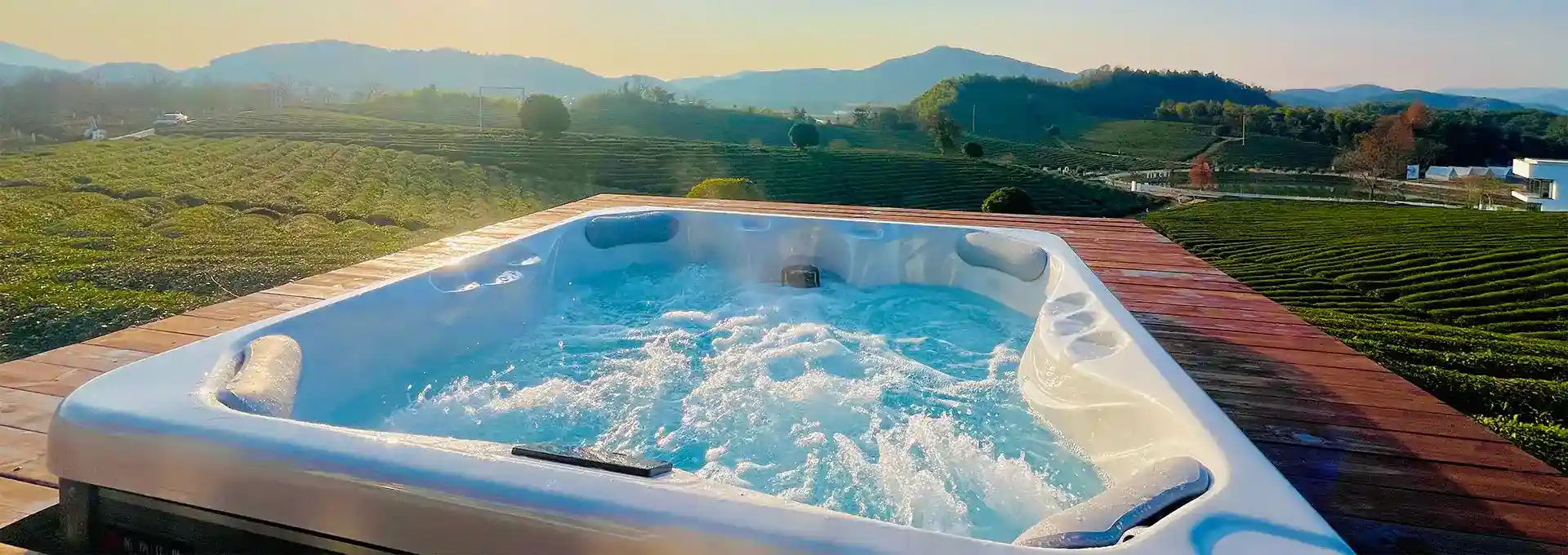How Hot Are Hot Tubs Usually?
2024-10-14 15:25:59
Hot tubs are a popular way to relax and unwind, offering a soothing retreat from the stresses of daily life. One of the key factors that contribute to the enjoyment of a hot tub experience is the water temperature. But how hot are 6-person hot tubs usually? The typical temperature range for hot tubs is between 100°F and 104°F (37.8°C to 40°C). This range provides a comfortable and therapeutic experience for most users while staying within safe limits. However, the ideal temperature can vary depending on personal preference, intended use, and health considerations.
What is the ideal temperature for a 6-person hot tub?
When it comes to a 6-person hot tub, the ideal temperature can depend on various factors, including the preferences of the users and the intended purpose of the soak. Generally, a temperature between 100°F and 102°F (37.8°C to 38.9°C) is considered ideal for most situations involving multiple users.
This temperature range offers a balance between comfort and safety. It's warm enough to provide the relaxation and therapeutic benefits that hot tub users seek, while not being so hot as to risk overheating or dehydration, especially during longer soaking sessions that are common in larger, 6-person hot tubs.
For social gatherings or family use, this temperature range is particularly suitable. It allows for comfortable conversation and extended use without causing excessive sweating or discomfort. The slightly lower end of this range (around 100°F) can be more appropriate for warmer days or when children will be using the hot tub, as they are more sensitive to heat.
However, if the hot tub is primarily used for hydrotherapy or muscle recovery, some users might prefer temperatures closer to 104°F (40°C). This higher temperature can help soothe sore muscles and joints more effectively, but it's important to limit the duration of use at these higher temperatures to avoid overheating.
It's worth noting that personal preference plays a significant role in determining the ideal temperature. Some users might find 100°F perfectly comfortable, while others might prefer it a bit warmer. The beauty of modern 6-person hot tubs is that they often come with precise temperature controls, allowing users to adjust the heat to their liking.
When setting the temperature for a 6-person hot tub, it's also important to consider energy efficiency. Maintaining a consistent temperature that's comfortable for most users can help reduce energy costs, as frequent large temperature adjustments can be energy-intensive.
How long can you safely stay in a hot tub?
The length of time you can safely enjoy a hot tub varies based on several factors, including water temperature, personal health, age, and individual heat tolerance. Generally, experts advise limiting sessions to between 15 and 30 minutes to ensure safety.
Typically, hot tubs are set between 100°F and 104°F, temperatures at which prolonged exposure can lead to overheating. The warm water inhibits the body’s natural cooling mechanism—sweating—potentially resulting in heat exhaustion symptoms such as dizziness, nausea, and fatigue.
However, if the hot tub is maintained at the lower end of this range (approximately 100°F), some individuals may extend their soak to 45 minutes or even an hour. It’s essential to pay attention to your body’s signals; if you begin to feel uncomfortable or lightheaded, exiting the hot tub is imperative.
Certain demographics should exercise additional caution regarding duration:
Pregnant Women: It’s generally recommended to limit hot tub use to no more than 10 minutes, as excessive heat exposure may pose risks to the developing fetus.
Children: Due to their smaller body mass and immature temperature regulation, children should have sessions capped at around 15 minutes.
Elderly Individuals: Those over 65 or with specific health conditions—like heart disease or high blood pressure—should consult healthcare providers for personalized guidance on safe usage and duration.
Staying hydrated is equally crucial while using a hot tub. The warm environment can lead to fluid loss through sweating, often unnoticed. To mitigate dehydration, drink water before, during, and after your soak.
Hot tub enthusiasts often find that incorporating breaks between sessions enhances overall enjoyment. For instance, you might soak for 15 minutes, pause for 10 minutes to cool down and hydrate, and then return for another round if desired.
These recommendations serve as general guidelines; individual tolerances can significantly differ. Always prioritize safety and comfort, and don’t hesitate to leave the hot tub if you start feeling unwell.
What are the benefits of using a 6-person hot tub?
A 6-person hot tub presents an array of benefits that transcend mere relaxation, offering both physical health advantages and enriched social experiences. Here’s an exploration of the myriad gains one can expect from indulging in this luxurious amenity.
Social Interaction and Bonding:
At the heart of a 6-person hot tub's appeal is its capacity to facilitate social gatherings. The inviting atmosphere encourages friends and family to unwind together, fostering deep conversations and meaningful connections. Whether reuniting with old acquaintances, enjoying family time, or entertaining guests, this spacious hot tub creates an unparalleled environment for comfort and intimacy.
Stress Relief and Mental Well-being:
Immersing oneself in warm water significantly alleviates stress. The soothing effects of hydrotherapy—coupled with gentle massage jets—work to lower cortisol levels, leading to enhanced mental health, improved sleep quality, and an overall feeling of well-being. The generous space of a 6-person hot tub allows users to shift positions comfortably, amplifying the relaxation experience.
Pain Relief and Muscle Recovery:
Renowned for its therapeutic properties, a hot tub is ideal for easing muscle tension and joint discomfort. The combination of heated water and targeted jet massages promotes quicker recovery from physical activity, making it particularly beneficial for athletes and those with chronic pain conditions. The diverse jet configurations available in larger models enable effective targeting of various muscle groups.
Enhanced Cardiovascular Health:
Regular hot tub use can positively impact cardiovascular health. The warmth causes blood vessels to dilate, improving circulation and potentially lowering blood pressure. However, individuals with existing heart conditions should seek medical advice before utilizing a hot tub.
Better Sleep Quality:
Soaking in a hot tub prior to bedtime can significantly enhance sleep quality. The body’s temperature drop after exiting warm water serves as a natural cue for sleep, aiding in falling asleep more easily and enhancing the overall sleep experience.
Romantic Ambiance:
For couples, a 6-person hot tub offers an intimate setting, allowing for comfortable arrangements that encourage quality time away from everyday distractions.
Year-Round Enjoyment:
Unlike conventional pools, hot tubs provide year-round enjoyment, even in colder climates. A 6-person hot tub becomes a warm retreat during winter months, extending outdoor living space and leisure opportunities.
Increased Property Value:
Installing a 6-person hot tub can elevate your property’s market value. Seen as a luxury feature, it enhances the home's appeal to prospective buyers, should you decide to sell in the future.
Customizable Experience:
Many larger hot tubs come equipped with advanced features, including multiple jet systems, ambient lighting, and entertainment options. This versatility allows users to tailor their experience, whether seeking an invigorating massage or a serene soak.
Respiratory Benefits:
The steam generated by a hot tub can aid in opening airways, providing relief for individuals with mild respiratory issues such as asthma or congestion. However, those with severe respiratory conditions should consult a physician prior to use.
In conclusion, a 6 person hot tub offers a multitude of benefits that cater to physical health, mental well-being, and social interaction. Its larger size and advanced features provide a versatile space for relaxation, therapy, and enjoyment, making it a valuable addition to any home. As with any health-related activity, it's important to use hot tubs responsibly and consult with a healthcare provider if you have any underlying health conditions.
For more information on hot tub installations and to find out more about our products, please feel free to contact us at info@iparnassus.com.
References
1. American Journal of Physiology-Heart and Circulatory Physiology. (2021). "Cardiovascular effects of hot water immersion."
2. Journal of Physiological Anthropology. (2019). "Effects of bathing on sleep quality."
3. International Journal of Aquatic Research and Education. (2020). "Hydrotherapy and wellness tourism."
4. Arthritis Research & Therapy. (2018). "Hydrotherapy for joint pain management."
5. Sleep Medicine Reviews. (2022). "Thermal therapy and sleep quality: A systematic review."
6. Journal of Athletic Training. (2021). "Hot water immersion in athletes: Effects on recovery and performance."
7. Clinical Rheumatology. (2020). "Balneotherapy in chronic musculoskeletal conditions."
8. Journal of Environmental and Public Health. (2019). "Health effects of recreational water activities."
9. International Journal of Environmental Research and Public Health. (2022). "Thermal therapy and mental health: A review."
10. Complementary Therapies in Medicine. (2021). "Hydrotherapy in pain management: A comprehensive review."



